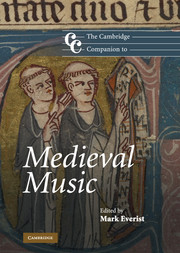Book contents
- Frontmatter
- Introduction
- Part I Repertory, styles and techniques
- Part II Topography
- Part III Themes, topics and trajectories
- 11 Music and liturgy
- 12 Vernacular poetry and music
- 13 Latin poetry and music
- 14 Compositional trajectories
- 15 Ecclesiastical foundations and secular institutions
- 16 Theory and notation
- 17 Music manuscripts
- 18 The geography of medieval music
- 19 Reception
- Notes
- Bibliography
- Index
14 - Compositional trajectories
from Part III - Themes, topics and trajectories
Published online by Cambridge University Press: 28 September 2011
- Frontmatter
- Introduction
- Part I Repertory, styles and techniques
- Part II Topography
- Part III Themes, topics and trajectories
- 11 Music and liturgy
- 12 Vernacular poetry and music
- 13 Latin poetry and music
- 14 Compositional trajectories
- 15 Ecclesiastical foundations and secular institutions
- 16 Theory and notation
- 17 Music manuscripts
- 18 The geography of medieval music
- 19 Reception
- Notes
- Bibliography
- Index
Summary
This chapter is intended to operate as a complement to the survey of musical theory presented in Chapter 16. Here, to illuminate a small set of issues in respect to style and compositional practice, we will approach the medieval composer via specific repertory, namely, some sacred chants and some two-voice polyphony.
A persistent conviction of many relative newcomers to medieval music is that all chant sounds the same – melodically vague, undifferentiable, hypnotic and slightly ‘New Age’ – and that it is governed by a universal, monolithic, standard medieval ‘theory of the modes’. Neither of these points is true, but one needs to gain a broad familiarity with some very large bodies of melodies, and the histories of their genres, to be able to come to grips with chant's diversity in all its dimensions, and it is equally important to learn some individual melodies very well.
The plainchant of the medieval Western church was, in fact, highly varied in musical language. There were different dialects, including Roman, Gallican, Mozarabic, Beneventan and Ambrosian, before and after the hegemonic rise of Gregorian chant circa 800. There are strong generic or functional fault lines within the Gregorian core itself (distinguishing prayer and reading tones, antiphonal psalmody, responsorial psalmody), and variant idioms emerged within the later Gregorian universe (e.g. the German chant tradition). On top of that, many different stylistic strands developed in all the newly composed, later medieval plainsong from the ninth century forward – melodies which over time far outdistanced the Gregorian core in sheer numbers.
- Type
- Chapter
- Information
- The Cambridge Companion to Medieval Music , pp. 241 - 262Publisher: Cambridge University PressPrint publication year: 2011



